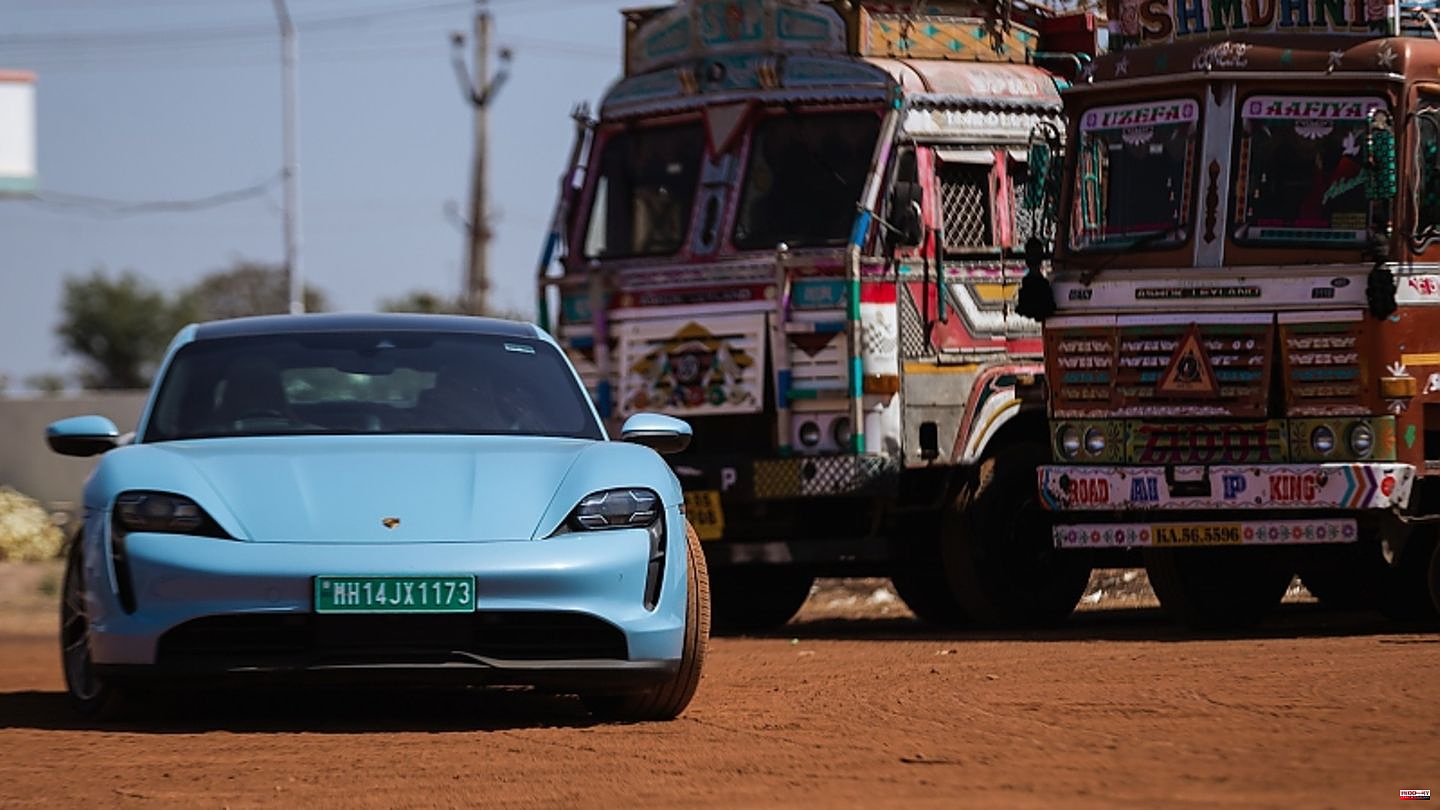For the car manufacturers, India has been the next big mega market for around 15 years, which should develop hundreds of millions of new buyers in the footsteps of China. Even if the numbers are gradually increasing, the great boom in India has not materialized so far. Newer vehicles, mostly locally produced by Tata or Maruti-Suzuki, are increasingly on the road, but a real boom market looks different. Millions of Indians are still on the road with bicycles, scooters or old rattle boxes with and without loading space. The government's requirement to become increasingly electric in the coming years seems like a mammoth task on a road trip through central India that hardly seems solvable.
The Indian city of Hyderabad secured a Formula E race for the first time this year. The world should look to India, see that there is more to it than the gigantic agglomerations of millions of Mumbai, Chennai or Delhi. Because Hyderabad also has something around seven million inhabitants. Exactly how much, no one here really knows. Road traffic is the way we have known it from Indian metropolises for decades. Orderly chaos reigns, because in reality two lanes become at least five. Rickshaws, motorcyclists and scooter drivers keep squeezing into the smallest gaps - it's a matter of centimetres. In addition, the continuous horn concert - you can like it - but you don't have to. Here, the light blue Porsche Taycan stands out in the wild confusion like a pink spaceship in the shape of a gigantic elephant that has landed on a distant planet. Hardly anyone who does not crane his head after the electric four-door. Three or four people are sitting on most motorcycles, cell phone cameras are clicking and everyone wants to get very close to this time machine that has landed in the middle of India from the future. The fact that it's 37 degrees in the shade and the dust covers everything in a light gray doesn't seem to bother anyone here. The ubiquitous dirt on the streets and sidewalks is probably also a matter of getting used to.
It passes Nehru Zoo and Chowmahalla Palace, one of Hyderabad's few well-known tourist attractions. The streets are just as dirty as most of the houses in the never-ending city center. Once the buildings open up a view of the surroundings, gloomy heaps of rubbish burn here and there. There are cars on the side of the road that have simply been left behind and you simply hang your washing on the balcony despite the dirt in the air. The electric Porsche Taycan seems to be just as unreal a time capsule as a Formula E race. But the Indian government has worked out a tight electric program for the coming years. Public transport consisting of buses, two-wheelers and three-wheelers is to become electric in stages. This should not only put the local population on the right track, but also strengthen the auto industry and encourage importers to invest. In recent years, local manufacturers and suppliers, together with the central government in Delhi and in the individual states, have switched politically from the pure combustion model to electric drives in order to make one of the largest car markets in the world fit for the future. “Two-wheelers, three-wheelers and buses are clearly the main beneficiaries of the government programs, while e-vehicles for passenger transport are currently in the background,” explains Bakar Sadik Agwan, analyst at Global Data, “however, the high proportion of the three segments in the total population justifies it why, and these segments can help meet the goal of 30 percent electrified new vehicles by 2030. Electric cars for passenger transport are an expensive purchase and face the challenge of gaining volume for personal mobility in the price-sensitive Indian market.”
The vehicles in India are currently on the road with normal combustion engines. And because super or diesel are now becoming more and more expensive, more and more people are switching to natural gas drives. A kilogram of natural gas costs just 24 rupees, while a liter of premium already costs 100 rupees. The number of charging stations is small even in a metropolis like Hyderabad. The tour to Mumbai, 800 kilometers away, will show what it looks like overland. In their luggage: an Indian credit card and a local mobile phone with the appropriate loading app. So it goes on the usual crowded roads west to Solapur. The charging stations are searched for using a smartphone, because this is the only way to get the current data. But if you want to recharge, you will quickly notice that not every charging station does its job here. It can happen that it is only the third or fifth charging station that fills the Taycan with energy.
First of all, the westbound MH65 dual carriageway is surprisingly well constructed. Permitted are 80 or even 100 km/h. From a speed of 120, the Taycan starts to beep annoyingly, so that the speed limit is kept within limits. Small agglomerations pass by irregularly on hundreds of kilometers to the left and right, and even towns such as Rudraram, Zaheerabad or Humnabad do not offer much more than gas stations, small snack shops and hotels in which, at least on the surface, you do not want to stay overnight. On Indian roads, you quickly get used to the fact that vehicles regularly come in the opposite direction, that people or animals cross the road unannounced, or that abandoned trucks protrude into the road. Again and again there are breaks in the road, protected by scary speed bumps that can only be passed at walking speed. It's a good thing that the front of the Taycan can be raised a few centimeters at the push of a button, because otherwise the Swabian's front apron would probably have already said goodbye shortly before Isnapur.
Due to the constant speed, the consumption of the Porsche Taycan is so low that, despite a few sprint passages, you can easily reach the factory specification. The Taycan is on the road with the small battery pack, of which just 71 kWh can be used. Nevertheless, the on-board computer shows that with the full battery pack in the underbody, around 400 kilometers are possible despite continuous operation of the automatic air conditioning and seat ventilation. When the card on the smartphone announces a fast charging station nearby next to a car repair shop, this is also used. The road is unpaved and there is dust like a red desert storm. Difficult to see: Tata installed a wall box on a house wall, which after all delivers 30 kW of charging power. After a short lunch nearby, not only is the battery noticeably stronger, but an Indian is waiting with his Tata Nexon to take over the plug. "I regularly commute from Pune to near Hyderabad," says Rameesh, who works for an IT company. "I just wanted to try out an electric car because I'm interested in the technology." Depending on how he drives, he manages 280 to 100 mph with one charge 300 kilometers. “I simply gave my diesel to my parents. After a year, the additional price paid for itself, because we get around 20 percent discounts here in India,” Rameesh smiles, “I drive the car for three, four or maybe five years. Let's see what I can sell it for." A few weeks ago, his entire battery pack was replaced once.
After countless toll stations, speed bumps and the chaotic traffic in the overnight town of Solapur, we head towards the coast the next morning. After a few minutes drive, a quick stop at a dusty sidewalk cafe that seems to be popular with taxi and rickshaw drivers. There is a choice of sugar with coffee or even more sugar with even less chai tea. The Indian apparently likes it particularly sweet and the blue Porsche Taycan is likely to be the crowd puller this morning for months to come. Some bring their friends and relatives to be photographed with the Porsche, which has been powered up in the hotel, for the digital album at home. Pune is crossed before continuing on to gigantic Mumbai on the west coast of India with its more than 20 million inhabitants. Real consumption has fallen again and, at just under 17 kWh per 100 kilometers, is now so low that the planned charging stop in the city of three million, known for its tech industry, could be omitted. According to information from the on-board computer, the Taycan would arrive at its destination with a remaining range of initially four to five and later nine percent. A total of more than 430 kilometers would be possible with a fully charged small battery - not bad.
But hunger and thirst make the loading stop on Senapati Bapat Road near the JW Marriott Hotel seem like a good place for a lunch break before cycling the last 150 kilometers. The traffic in Pune is wild and chaotic, because there is a fight for every inch of the road - wild honking, but friendly. That's how the Indians are. The four lanes become eight when crossing Pune and that in the meantime trucks have collapsed exhausted, the temperature has long since broken through the 39-degree mark and all cell phone cameras continue to click at the sight of the blue time machine, one has become just as used to that as that you can't leave ten centimeters of space forward. The distance to the left and right of motorbikes and hundreds of rickshaws is even smaller than one would like for a car that costs the equivalent of at least 260,000 euros here with penalty taxes. Two and a half times more than in Europe. On the other hand: where can you get a real spaceship for so little money?
With the same almost physical contact, after the successful quick charge with just over 70 kilowatts, it continues to the final destination of the trip, Mumbai. Spectacular is the steep descent on the NH48 between Amrutvela, a luxury enclave of the rich Mumbaians, and Gadabagunda, where apparently some vehicles have left the slope on the right or the steep mountain walls on the left. Anyone who looks at the tire profile of many vehicles and their general technical condition knows why. On the last 50 kilometers into Mumbai, past speed traps that have appeared for the first time and more police checks, it's time to say goodbye. About extremely friendly Indians, surprisingly good highways, a terrifically economical Porsche Taycan and countless towns whose names you can hardly remember. With them the thoughts of brutal speed bumps, a few non-functioning charging stations and doubts as to whether electric mobility will be a thing in India by 2030. But that they will also come here – only a few doubt that.







